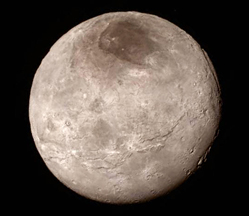|
On July 14, 2015, New Horizons took this image of Pluto that awed the world.

The
success of the mission to Pluto was greeted with much well-deserved
publicity. But one fascinating aspect of this story received scant
attention. This $700 million mission was literally a shot in the dark
that was saved by old-school astronomy.
Remarkably, when New Horizons was launched in January 2006, Pluto’s orbit was known with a precision of only 0.002%, which seems fine, but isn’t nearly good enough.
NASA has
been so successful in so many missions that everyone assumes they know
where they’re going. The Mars Curiosity Rover, for example, landed
within 1.5 miles of its target.
But Pluto
is very different; it takes 248 years to loop around the Sun. Since
Clyde Tombaugh discovered it in 1930, Pluto has completed only 1/3 of an
orbit. It hasn’t been where it is now since 1767, six years before the
Boston Tea Party.
Adding to
the drama, New Horizons takes wonderful pictures, but does no image
analysis — it’s strictly point-and-shoot. Scientists at Mission Control
must tell New Horizons where to point and when to shoot.
Modern
high-precision observations of Pluto began fairly recently.
Extrapolating this data to the flyby date left Pluto’s location
uncertain by 62,000 miles. New Horizon’s aim could have been off by 44
Pluto diameters.
Flying at
32,000 mph, New Horizons moves one Pluto diameter in under 3 minutes.
That’s a time window of 0.000,06% in a 9.5-year mission.
Realizing
Pluto’s orbital uncertainty could well be catastrophic, navigation team
leader Dr. Marc Buie, perhaps echoing Jim Lovell on Apollo 13, said
simply: “We have a problem.”
Exploration
is all about conquering the unknown and overcoming uncertainty. If
everyone in 1969 knew how to land on the Moon and return safely,
everyone would have done it. Only NASA did.
So how did the New Horizons team overcome this problem?
Six years
after launch, Buie visited the Lowell Observatory where Tombaugh
discovered Pluto. Tombaugh’s images were too blurry, but Buie happened
to find archived photographs taken by Carl Lampland over a 20-year
period ending in the 1950’s. For reasons that had nothing to do with
Pluto, Lampland took 1000 pictures of the same piece of sky. By sheer
luck, Pluto just happened to be there.
Using the
best current technology, Buie meticulously digitized 1000 very old
photographs, and calculated Pluto’s orbit with unprecedented precision —
and just in time.
After it passed Pluto, New Horizons turned and took this image of Pluto eclipsing the Sun.

This shows Pluto’s atmosphere is over 100 miles thick, much larger than scientists had guessed.
|